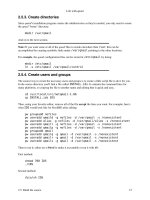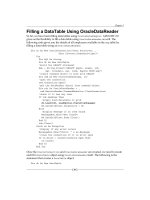Object-Oriented Programming with PHP 5 phần 3 potx
Bạn đang xem bản rút gọn của tài liệu. Xem và tải ngay bản đầy đủ của tài liệu tại đây (346.31 KB, 26 trang )
Kick-Starting OOP
[ 40 ]
Using Magic Methods to Set/Get Class
Properties
We discussed in the previous section that writing accessor method for a number
of properties will be a real nightmare. To avoid that boredom, you can use magic
methods. This process is called property overloading.
PHP5 introduced some magic methods in classes to reduce the pain of OOP in some
cases. Two of those magic methods are introduced to set and get dynamic property
values in a class. These two magic methods are named as __get() and __set(). Let
us see how to use them:
<?
//class.student.php
class Student
{
private $properties = array();
function __get($property)
{
return $this->properties[$property];
}
function __set($property, $value)
{
$this->properties[$property]="AutoSet {$property} as: ".$value;
}
}
?>
Now let us see the code in action. Use the class above with the following script:
<?
$st = new Student();
$st->name = "Afif";
$st->roll=16;
echo $st->name."\n";
echo $st->roll;
?>
When you execute the preceding code, PHP recognizes immediately that no property
named name or roll exists in the class. Since the named property doesn't exist,
the __set() method is called, which then assigns the value to the newly-created
property of the class, allowing you to see the following output:
AutoSet name as: Afif
AutoSet roll as: 16
Chapter 2
[ 41 ]
Seems quite interesting, huh? Using magic methods you still have full control over
setting and retrieving property values in classes. However, you have one limitation
if you use magic methods. While using reection API, you can't investigate class
properties (we will discuss about reection API in a later chapter). Moreover, your
class lost the "readability" and "maintainability" quite a lot. Why? See the code of
previous Student class and new Student class and you will understand that
for yourself.
Magic Methods for Overloading Class
Methods
Like overloading, and using the accessor methods, there are magic methods
to overload any method call in a class. If you are still not familiar with method
overloading, then this is a process of accessing any method that doesn't even exist in
the class. Sounds funny, right? Let's take a closer look.
There is a magic method, which helps to overload any method call in PHP5 class
context. The name of that magic method is __call(). This allows you to provide
actions or return values when undened methods are called on an object. It can be
used to simulate method overloading, or even to provide smooth error handling
when an undened method is called on an object. __call takes two arguments: the
name of the method and an array of the arguments passed to the undened method.
For example see the code below:
<?
class Overloader
{
function __call($method, $arguments)
{
echo "�ou called a method named {$method} with the following
arguments <br/>";
print_r($arguments);
echo "<br/>";
}
}
$ol = new Overloader();
$ol->access(2,3,4);
$ol->notAnyMethod("boo");
?>
Kick-Starting OOP
[ 42 ]
If you see the code above, then you will see that there is no method called access
and notAnyMethod. So therefore, it should raise an error, right? However, the
method overloader still helps you to call any non existing method. If you execute the
code above, you will get the following output.
�ou called a method named access with the following arguments
Array
(
[0] => 2
[1] => 3
[2] => 4
)
�ou called a method named notAnyMethod with the following arguments
Array
(
[0] => boo
)
That means you will get all arguments as an array. There are many more magic
methods, which you will learn step-by-step in this book.
Visually Representing a Class
In OOP, sometimes you have to visually represent your class. Let's learn how to
visually represent a class. For this, we will use our Emailer class this time.
class Emailer
_construct($sender)
addRecipients($resc)
setSubject($subject)
setBody($body)
sendEmail()
$sender
$recipient
$subject
$body
In this graphical representation, there are three sections. At the top most section
a class name should be written. In the second section all methods with or without
parameters are written. And in the third box all the properties are written. That's it!
Chapter 2
[ 43 ]
Summary
In this chapter we have learned how to create objects and interact between them.
PHP5 brings amazing improvements in object models when compared to PHP4.
Zend Engine 2, which is at the core of PHP5, is also very efcient in handling these
features with great performance optimization.
In the next chapter we will go through more details and the core features of OOP
in PHP. But before starting next chapter, please practice everything discussed here,
otherwise you may get confused in some topics. Practice them as much as you can,
try to refactor all your previous code in OOP. The more you practice, the more
efcient you become.
More OOP
The previous chapter creates a basis for us to kick-start OOP with PHP. This chapter
will deal with some advanced features in more detail. For example, we will learn
about class information functions by which we can investigate details about any
class. We will then learn about some handy object-oriented information functions
and also one of the great new features in PHP5, which is exception handling.
This chapter will also introduce us to the Iterators for easier array access. To store
any object for later use, we need to use a special feature in OOP which is called
serialization, we will also learn about this here. As a whole this chapter will
strengthen your base in OOP.
Class Information Functions
If you want to investigate and gather more information regarding any class, these
functions will be your light in the dark. These functions can retrieve almost any
information regarding a class. But there is an improved version of these functions
and is introduced as a totally new set of API in PHP5. That API is called reection.
We will learn about reection API in Chapter 5.
Checking if a Class Already Exists
When you need to check if any class already exists in the current scope, you can use
a function named class_exists(). Have a look at the following example:
<?
include_once(" /ch2/class.emailer.php");
echo class_exists("Emailer");
//returns true otherwise false if doesn't exist
?>
More OOP
[ 46 ]
The best way to use the class_exists() function is to rst check if a class is already
available. You can then create an instance of that class if it is available. This will
make your code much more stable.
<?
include_once(" /ch2/class.emailer.php");
if( class_exists("Emailer"))
{
$emailer = new Emailer("");
}
else
{
die("A necessary class is not found");
}
?>
Finding Currently Loaded Classes
In some cases you may need to investigate which classes are loaded in the current
scope. You can do it pretty ne with the get_declared_classes() function. This
function will return an array with currently available classes.
<?
include_once(" /ch2/class.emailer.php");
print_r(get_declared_classes());
?>
You will see a list of currently available classes on the screen.
Finding out if Methods and Properties Exists
To nd out if a property and/or a method is available inside the class, you can
use the method_exists() and property_exists() functions. Please note, these
functions will return true only if the properties and methods are dened in
public scope.
Checking the Type of Class
There is a function called is_a() that you can use to check the type of class. Take a
look at the following example:
<?
class ParentClass
{
Chapter 3
[ 47 ]
}
class ChildClass extends ParentClass
{
}
$cc = new ChildClass();
if (is_a($cc,"ChildClass")) echo "It's a ChildClass Type Object";
echo "\n";
if (is_a($cc,"ParentClass")) echo "It's also a ParentClass Type
Object";
?>
You will nd the output as follows:
Its a ChildClass Type Object
Its also a ParentClass Type Object
Finding Out the Class Name
In the previous example we checked the class if it's a type of a known one. What if
we need to get the original name of the class itself? No worry, we have the
get_class() function to help us.
<?
class ParentClass
{
}
class ChildClass extends ParentClass
{
}
$cc = new ChildClass();
echo get_class($cc)
?>
As an output, you should get ChildClass. Now take a look at the following
example, which "brjann" enlisted as unexpected behaviour in the PHP manual user
note section.
<?
class ParentClass
{
public function getClass()
{
echo get_class(); //using "no $this"
}
}
class Child extends ParentClass
{
More OOP
[ 48 ]
}
$obj = new Child();
$obj->getClass(); //outputs "ParentClass"
?>
If you run this code, you will see ParentClass as the output. But why? You are
calling the method for a Child. Is it unexpected? Well, no. Take a serious look at
the code. Though the Child extended the ParentClass object, it didn't override the
method getClass(). So the method is still running under a ParentClass scope.
That's why it returns the result ParentClass.
So what actually happened to the following piece of code? Why is it returning Child?
<?
class ParentClass {
public function getClass(){
echo get_class($this); //using "$this"
}
}
class Child extends ParentClass {
}
$obj = new Child();
$obj->getClass(); //outputs "child"
?>
In the ParentClass object, the get_class() function returns $this object, which
clearly holds a reference of Child class. That's why you are getting Child as
your output.
Exception Handling
One of the most improved features in PHP5 is that you can now use exceptions, like
other OOP languages out there. PHP5 introduces these exception objects to simplify
your error management.
Let's see how these exceptions occur and how to handle them. Take a look at the
following class, which simply connects to a PostgreSQL server. In the case of failing
to connect to the server, let's see what it usually returns:
<?
//class.db.php
class db
{
function connect()
{
Chapter 3
[ 49 ]
pg_connect("somehost","username","password");
}
}
$db = new db();
$db->connect();
?>
The output is the following.
<b>Warning</b>: pg_connect() [<a href='function.pg-connect'>
function.pg-connect</a>]: Unable to connect to PostgreSQL
server: could not translate host name "somehost" to address:
Unknown host in <b>C:\OOP with PHP5\Codes\ch3\exception1.php</b>
on line <b>6</b><br />
How are you going to handle it in PHP4? Generally, by using something similar to
the following shown below:
<?
//class.db.php
error_reporting(E_ALL - E_WARNING);
class db
{
function connect()
{
if (!pg_connect("somehost","username","password")) return false;
}
}
$db = new db();
if (!$db->connect()) echo "Falied to connect to PostgreSQL Server";
?>
Now let's see how we can solve it with exception.
<?
//class.db.php
error_reporting(E_ALL - E_WARNING);
class db
{
function connect()
{
if (!pg_connect("host=localhost password=pass user=username
dbname=db")) throw new Exception("Cannot connect
to the database");
}
More OOP
[ 50 ]
}
$db = new db();
try {
$db->connect();
}
catch (Exception $e)
{
print_r($e);
}
?>
The output will be something like this:
Exception Object
(
[message:protected] => Cannot connect to the database
[string:private] =>
[code:protected] => 0
[file:protected] => C:\OOP with PHP5\Codes\ch3\exception1.php
[line:protected] => 8
[trace:private] => Array
(
[0] => Array
(
[file] => C:\OOP with PHP5\Codes\ch3\exception1.php
[line] => 14
[function] => connect
[class] => db
[type] => ->
[args] => Array
(
)
)
[1] => Array
(
[file] => C:\Program Files\Zend\ZendStudio-
5.2.0\bin\php5\dummy.php
[line] => 1
[args] => Array
(
[0] => C:\OOP with PHP5\Codes\ch3\exception1.php
)
[function] => include
)
)
)
Chapter 3
[ 51 ]
So you get a lot of things in this exception class. You can catch all the errors using
this try-catch block. You can use try-catch inside another try-catch block. Take a look
at the following example. Here we developed two of our own exception objects to
make the error handling more structured.
<?
include_once("PGSQLConnectionException.class.php");
include_once("PGSQLQueryException.class.php");
error_reporting(0);
class DAL
{
public $connection;
public $result;
public function connect($ConnectionString)
{
$this->connection = pg_connect($ConnectionString);
if ($this->connection==false)
{
throw new PGSQLConnectionException($this->connection);
}
}
public function execute($query)
{
$this->result = pg_query($this->connection,$query);
if (!is_resource($this->result))
{
throw new PGSQLQueryException($this->connection);
}
//else do the necessary works
}
}
$db = new DAL();
try{
$db->connect("dbname=golpo user=postgres2");
try{
$db->execute("select * from abc");
}
catch (Exception $queryexception)
{
echo $queryexception->getMessage();
}
}
catch(Exception $connectionexception)
{
echo $connectionexception->getMessage();
}
?>
More OOP
[ 52 ]
Now, if the code cannot connect to DB, it catches the error and displays that
Sorry, couldn't connect to PostgreSQL server: message. If the connection is
successful but the problem is in the query, it will display the proper information.
If you check the code, then you will nd that for a connection failure we throw
a PGSQLConnectionException object, and for a query failure we just throw a
PGSQLQueryException object. We can custom develop these objects by extending
the core Exception class of PHP5. Let's take a look at the code. The rst one is the
PGSQLConnectionException class.
<?
Class PGSQLConnectionException extends Exception
{
public function __construct()
{ $message = "Sorry, couldn't connect to postgresql server:";
parent::__construct($message, 0000);
}
}
?>
And here comes PGSQLQueryException class
<?
Class PGSQLQueryException extends Exception
{
public function __construct($connection)
{
parent::__construct(pg_last_error($connection),0);
}
}
?>
That's it!
Collecting all PHP Errors as Exception
If you want to collect all PHP errors (except the FATAL errors) as exception, you can
use the following code:
<?php
function exceptions_error_handler($severity, $message,
$filename, $lineno) {
throw new ErrorException($message, 0, $severity,
$filename, $lineno);
}
set_error_handler('exceptions_error_handler');
?>
Chapter 3
[ 53 ]
The credit of the above code piece goes to , which I collected
from the PHP manual user notes.
Iterators
An Iterator is a new command introduced in PHP5 to help traversing through any
object. Check out the following example to understand what Iterators are actually
used for. In PHP4 you could iterate through an array as shown in the following
example, using foreach statement:
<?
foreach($anyarray as $key=>$val)
{
//do something
}
?>
You could also perform a foreach operation over an object, let's take a look at theoperation over an object, let's take a look at the
following example.
<?
class EmailValidator
{
public $emails;
public $validemails;
}
$ev = new EmailValidator();
foreach($ev as $key=>$val)
{
echo $key."<br/>";
}
?>
This code will output the following:
emails
validemails
Please note that it can only iterate through the public properties. But what if we
want just the valid email addresses as the output? Well, in PHP5 that's possible by
implementing the Iterator and IteratorAggregator interface. Let us see using the
following example. In this example, we create a QueryIterator, which can iterate
through a valid PostgreSQL query result and returns one row per Iteration.
<?
class QueryIterator implements Iterator
{
private $result;
More OOP
[ 54 ]
private $connection;
private $data;
private $key=0;
private $valid;
function __construct($dbname, $user, $password)
{
$this->connection = pg_connect("dbname={$dbname} user={$user}");
}
public function exceute($query)
{
$this->result = pg_query($this->connection,$query);
if (pg_num_rows($this->result)>0)
$this->next();
}
public function rewind() {}
public function current() {
return $this->data;
}
public function key() {
return $this->key;
}
public function next() {
if ($this->data = pg_fetch_assoc($this->result))
{
$this->valid = true;
$this->key+=1;
}
else
$this->valid = false;
}
public function valid() {
return $this->valid;
}
}
?>
Let's see the code in action.
<?
$qi= new QueryIterator("golpo","postgres2","");
$qi->exceute("select name, email from users");
while ($qi->valid())
{
Chapter 3
[ 55 ]
print_r($qi->current());
$qi->next();
}
?>
For example, if there are two records in our table users, you will get the following
output:
Array
(
[name] => Afif
[email] =>
)
Array
(
[name] => Ayesha
[email] =>
)
Quite handy, don't you think?
ArrayObject
Another useful object introduced in PHP5 is ArrayObject that wraps the regular
PHP array and gives it an OO avor. You can programmatically access the array
in an OO style. You can create an ArrayObject object by simply passing to
ArrayObject constructor. ArrayObject has the following useful methods:
append()
This method can add any value at the end of the collection.
getIterator()
This method simply creates an Iterator object and return so that you can perform
iteration using an Iterator style. This is a very useful method for getting an Iterator
object from any array.
offsetExists()
This method can determine whether the specied offset exists in the collection.
offsetGet()
This method returns the value for specied offset.
More OOP
[ 56 ]
offsetSet()
Like offsetGet(), this method can set any value to the specied index().
offsetUnset()
This method can unset the element at specied index.
Let us see some examples of ArrayObject:
<?
$users = new ArrayObject(array("hasin"=>"",
"afif"=>"",
"ayesha"=>""));
$iterator = $users->getIterator();
while ($iterator->valid())
{
echo "{$iterator->key()}'s Email address is
{$iterator->current()}\n";
$iterator->next();
}
?>
Array to Object
We can access any array element by its key, for example $array[$key]. However,
what if we want to access it like this, $array->key style? It's very easy and we can
do it by extending ArrayObject. Let's see using the following example.
<?
class ArrayToObject extends ArrayObject
{
public function __get($key)
{
return $this[$key];
}
public function __set($key,$val)
{
$this[$key] = $val;
}
}
?>
Now let's see it in action:
<?
$users = new ArrayToObject(array("hasin"=>"",
"afif"=>"",
Chapter 3
[ 57 ]
"ayesha"=>""));
echo $users->afif;
?>
It will output the email address associated with the key afif, as follows:
This example may come in handy if you want to convert the array of any known
format into an object.
Accessing Objects in Array Style
In the previous section we learned how to access any array in OO style. What if we
want to access any object in array style? Well, PHP provides that facility too. All you
have to do is implement ArrayAccess interface in your class.
ArrayAccess interface has four methods, which you must implement in the class.
The methods are offsetExists(), offsetGet(), offsetSet(), offsetUnset().
Let's create a sample class implementing ArrayAccess interface.
<?php
class users implements ArrayAccess
{
private $users;
public function __construct()
{
$this->users = array();
}
public function offsetExists($key)
{
return isset($this->users[$key]);
}
public function offsetGet($key)
{
return $this->users[$key];
}
public function offsetSet($key, $value)
{
$this->users[$key] = $value;
}
public function offsetUnset($key)
{
unset($this->users[$key]);
}
More OOP
[ 58 ]
}
$users = new users();
$users['afif']="";
$users['hasin']="";
$users['ayesha']="";
echo $users['afif']
?>
The output will be
Serialization
So far we have learned how we can create objects and manipulate them. Now what
happens if you need to save any state of the object and retrieve it later exactly in that
form? In PHP, you can achieve this functionality by serialization.
Serialization is a process of persisting the state of an object in any location, either
physical les or in variables. To retrieve the state of that object, another process
is used which is called "unserialization". You can serialize any object using
serialize() function. Let's see how we can serialize an object:
<?
class SampleObject
{
public $var1;
private $var2;
protected $var3;
static $var4;
public function __construct()
{
$this->var1 = "Value One";
$this->var2 = "Value Two";
$this->var3 = "Value Three";
SampleObject::$var4 = "Value Four";
}
}
$so = new SampleObject();
$serializedso =serialize($so);
file_put_contents("text.txt",$serializedso);
echo $serializedso;
?>
Chapter 3
[ 59 ]
The script will output a string, which PHP understands how to unserialize.
Now it's time to retrieve our serialized object and convert into a usable PHP object.
Please bear in mind that the class le you are unserializng must be loaded rst.
<?
include_once("class.sampleobject.php");
$serializedcontent = file_get_contents("text.txt");
$unserializedcontent = unserialize($serializedcontent);
print_r($unserializedcontent);
?>
What do you think the output will be? Take a look:
SampleObject Object
(
[var1] => Value One
[var2:private] => Value Two
[var3:protected] => Value Three
)
It's now a regular PHP object; the same as it was just before serializing. Please note
that all variables keep their values, which were set before serializing, except the static
one. You cannot save the state of a static variable by serializing.
What if we didn't include the class le by include_once before unserializing? Let's
just comment out the rst line, which includes the class le and then run the example
code. You will get the following output:
__PHP_Incomplete_Class Object
(
[__PHP_Incomplete_Class_Name] => SampleObject
[var1] => Value One
[var2:private] => Value Two
[var3:protected] => Value Three
)
At this point, you can't use it as the object again.
Magic Methods in Serialization
Do you remember we overloaded properties and methods using some magic
methods like __get, __set, and __call? For serialization, you are allowed to use
some magic methods to hook into the process of serialization. PHP5 provides two
magic methods for this purpose named __sleep and __awake. These methods give
some control over the whole process.
More OOP
[ 60 ]
Let's develop all the static variables of a process using these magic methods, which
we generally won't be able to do without a hack. Normally it's not possible to
serialize the values of any static variables and return the object in same state with
that static variable. However, we can make it happen, let's see the following code.
<?
class SampleObject
{
public $var1;
private $var2;
protected $var3;
public static $var4;
private $staticvars = array();
public function __construct()
{
$this->var1 = "Value One";
$this->var2 = "Value Two";
$this->var3 = "Value Three";
SampleObject::$var4 = "Value Four";
}
public function __sleep()
{
$vars = get_class_vars(get_class($this));
foreach($vars as $key=>$val)
{
if (!empty($val))
$this->staticvars[$key]=$val;
}
return array_keys( get_object_vars( $this ) );
}
public function __wakeup()
{
foreach ($this->staticvars as $key=>$val){
$prop = new ReflectionProperty(get_class($this), $key);
$prop->setValue(get_class($this), $val);
}
$this->staticvars=array();
}
}
?>
Chapter 3
[ 61 ]
What happens if we serialize the object, write it into the le and then later retrieve
the state? You will nd the static value still persists the last value assigned to it.
Let's discuss the code for a second. The __sleep function performs all the necessary
operations. It searches for public properties with values and stores the variable's
name when it nds one into a private variable staticvars. Later when someone
tries to unserialize the object, it retrieves each value from the staticvars and writes
it to the property itself. Pretty handy, don't you agree?
You will notice that we haven't used a hack, with the exception of the theoretical
capability of the __sleep() and __wakeup() functions. So what are these two
functions useful for? Where can we use them in practice? This is actually fairly
simple. For example, if your class has any resource object associated with it (a live
DB connection, a reference of an open le) in sleep function you can properly close
them as they are no longer usable when someone unserializes it. Please remember
that in an unserialized state someone may still use those resource pointers. So in the
__wakeup() function you can open those DB connections, or le pointers, to give it
an exact shape as it was before. Let us see using the following example:
<?
class ResourceObject
{
private $resource;
private $dsn;
public function __construct($dsn)
{
$this->dsn = $dsn;
$this->resource = pg_connect($this->dsn);
}
public function __sleep()
{
pg_close($this->resource);
return array_keys( get_object_vars( $this ) );
}
public function __wakeup()
{
$this->resource = pg_connect($this->dsn);
}
}
?>
More OOP
[ 62 ]
This object, when being serialized, will free the memory that was consumed by
$resource. Later, when it will be unserialized, it will open the connection again
using the DSN string. So now, after unserialization, everything is as it was before.
That's the clue!
Object Cloning
PHP5 introduces a new approach while copying objects from one into another,
which is quite different to PHP4. In PHP4 when you copy an object to another, it
performs a deep copy. This means it just makes a completely new object, which
retains the properties of the object being copied. However, changing anything in the
new object will not affect the main object.
PHP5 is different from this in the way it makes a shallow copy when you copy
an object from one to another. To clearly understand the situation, you need to
understand the following code.
<?
$sample1 = new StdClass();
$sample1->name = "Hasin";
$sample2 = $sample1;
$sample2->name = "Afif";
echo $sample1->name;
?>
If you run the above code in PHP5 can you guess what will you get as the result?
Hasin or Afif? Surprisingly, the output is Afif. As I mentioned earlier, PHP5
performs a shallow copy while copying an object; $sample2 is just a reference to
$sample1. So whenever you perform any change to $sample1 object or $sample2
object, it will affect both.
In PHP4 it works differently; it will output Hasin, as both are different from
each other.
If you want to perform the same in PHP5, you have to use the clone keyword. Let's
take a look at the following example
<?
$sample1 = new stdClass();
$sample1->name = "Hasin";
$sample2 =clone $sample1;
$sample2->name = "Afif";
echo $sample1->name;
?>
The output now would be Hasin.
Chapter 3
[ 63 ]
Autoloading Classes or Classes on
Demand
While working with big projects, another very good practice is loading classes only
when you need it. That means you shouldn't over consume the memory by loading
unnecessary classes all the time.
In our examples, you have seen that we include the original class le before making
them available in our script. Unless you include the class le, you can't create an
instance of it. PHP5 introduces a feature to auto load your class les so that you
don't have to bother to include them manually. Usually, this feature is helpful in big
applications where you have to deal with lots of classes and don't want to bother to
call include all the time. Take a look at the following example:
<?
function __autoload($class)
{
include_once("class.{$class}.php");
}
$s = new Emailer("");
?>
When you execute the script shown above, note that we didn't include any class le
for the Emailer class. Because of this __autoload() function, PHP5 will auto load
a le named class.emailer.php in the current directory. So you need not worry
about including the class yourself.
Method Chaining
Method chaining is another process introduced in PHP5 by which you can directly
access the methods and attributes of an object when it is returned by any function. It
is something like the following:
$SomeObject->getObjectOne()->getObjectTwo()->callMethodOfObjectTwo();
The above code means that $someObject class has a method named
getObjectOne() which returns an object named $objectOne. This $objectOne has
another method named getObjectTwo() which returns an object whose method is
called by the nal call.
So who is going to use such things? Let's take a look at the following code; it makes
you understand beautifully how a method chain can be used in real life:
$dbManager->select("id","email")->from("user")->where("id=1")
->limit(1)->result();
More OOP
[ 64 ]
Do you nd the above code meaningful and readable? The code returns a row from
the user table containing the ID and email where the value of ID is equal to 1. Have
you ever wondered how to design such a DB manager object? Let's take a look at this
great example below:
<?
class DBManager
{
private $selectables = array();
private $table;
private $whereClause;
private $limit;
public function select()
{
$this->selectables=func_get_args();
return $this;
}
public function from($table)
{
$this->table = $table;
return $this;
}
public function where($clause)
{
$this->whereClause = $clause;
return $this;
}
public function limit($limit)
{
$this->limit = $limit;
return $this;
}
public function result()
{
$query = "SELECT ".join(",",$this->selectables)." FROM
{$this->table}";
if (!empty($this->whereClause))
$query .= " WHERE {$this->whereClause}";
if (!empty($this->limit))
$query .= " LIMIT {$this->limit}";
echo "The generated Query is : \n".$query;
}
}
$db= new DBManager();
$db->select("id","name")->from("users")->where("id=1")->
limit(1)->result();
?>









